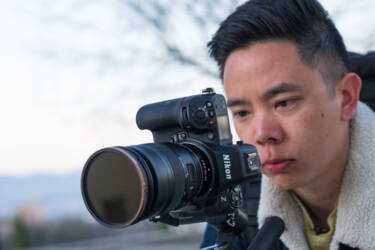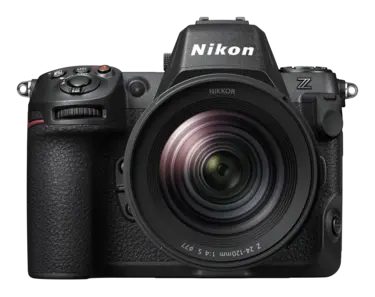How to take video portraits

Make your subject come to life with the new Nikon Z 8
In these days of TikTok, it seems everything now moves.
And so even the portrait, one of the mainstays of stills photography, has been enriched by the moving image, with more and more clients asking for video portrait to be added to the shoot deliverables list.
With the new Nikon Z 8, the quick video set-up makes it the perfect camera for taking your video portrait sessions to the next level.
If you are an experienced stills portrait shooter, you already have the most important skill you need: dealing with people! The same goes for a video portrait shoot. You’re shooting a person, not a bowl of fruit so, whether stills or video, striking up a relationship and relaxing the subject – particularly if they are not used to being shot – is key.
For a non-professional subject or presenter, the presence of a camera can be offputting, but they only have to concentrate for seconds for stills. Now imagine how they might feel concentrating for 30 seconds while someone is filming them. In silence, no less.
As with stills, you want a video portrait to really reveal something about the person. Unlike stills, though, you have other tools at your disposal to enhance that story even further: formats, camera moves, music, editing. It’s a very exciting palette to draw from, and the Nikon Z 8’s features enable you to concentrate less on equipment and more on being creative.

Vertical videography with Olivier Wong
Click the button to play
Let’s start with formats
With the Nikon Z 8, you get options for 12-bit Raw, 10-bit ProRes 422 and N-Log. These ‘pro’ formats can be offputting to those unfamiliar with regular video work but, as Raw is to JPEG for stills, they open up a world of creative possibilities post-shoot.
Colour grading can be seen as some mysterious dark art, but even the simplest grade can make your footage truly cinematic. You’ll never look back when you see the potential for drastically shifting colour, mood or contrast with the incredible dynamic range these formats offer.
In the Z 8, the fact that these pro formats can be recorded in camera is game-changing (at least that’s what wedding and fine art photographer Frøydis Geithus says). No need for an external field recorder to capture RAW footage. That means less weight, fewer batteries and fewer power leads.
Less weight also means it’s much easier to go for hand-held shots and move the camera around, while fewer gizmos attached to the camera can be less intimidating for the subject.
When shooting, think about your frame rate
Twenty-five frames is cool, but bumping up to at least 50 gives you a lot more edit-friendly options later. 4K at a 120fps on the Z 8 will give you some seriously impressive slow-mo and has an instant ‘cinema’ feel to it. And 8K capability gives you not just multiple zoom options from the same piece of footage, but also the ability to extract amazing stills from video. That’s great for portrait shoots where both video and stills are required, but time is tight.
Whether you want a great-looking HD MP4 straight out of the camera to ping on to a client’s social media or a 4K 12-bit RAW file to dial in some creative colour grading later, you can shoot both with the Z 8.
The AF on the Z 8 lets you spend a lot more time thinking about being creative rather than worrying about focus points. Even with the most active subjects, focus for your video portraits is practically ‘set-and-forget’, meaning you can just concentrate on getting a great frame and creating some great camera moves, and be confident every take will be tack sharp, with no focus breathing issues.
In-camera Vibration Reduction, especially when matched with a NIKKOR Z VR lens, means that for most of the time you can leave the gimbal or the runner at home – really useful for shooting a video portrait at challenging locations where transporting lots of gear is not a viable option.
The full-size HDMI port on the Z 8 means you can quickly attach to a full-size TV in a studio environment and play back footage to the subject as you go along. This is always useful and a great way to keep the subject involved in the process, creating some of the vital collaborative feel of a portrait shoot.
Mostly, the Z 8 will enable you to expand your creative horizons with video portraits and get the all-important result: a portrait that tells a compelling story about your subject. Packed with technology that becomes liberating and is designed with the user in mind, it means you can push your shoots further than ever.
It’s ready to go when you and the subject are
With no compromise on either side of the video/stills coin, the Nikon Z 8 is portrait perfection. It’s a pro-level stills camera with the powerful features of a pro-level video camera and contains the dynamic range and colour IQ that makes every frame a great still image in its own right.
Need to ace a TikTok? Read travel videographer and content creator Olivier Wong’s guide to shooting vertical video with the Z 8 here.
As with stills, you want a video portrait to really reveal something about the person. Experiment with formats, camera moves, music, editing…
8 top tips for video portraits
- Ask yourself: “Why am I here?” “What is the purpose of the shoot?” Are you promoting someone’s YouTube channel, their shop opening, their mountain climb for charity? A new song? Answering that clearly from the start will give an immediate purpose to the shoot and all subsequent decisions can flow from that.
- Pick a sympathetic space for your subject. Your choice of scene will really help start a strong narrative from the first frame. The location will also dictate some early gear choices – whether you need lights or just a reflector, for example.
- Plan the edit style you want to have before the shoot. A smooth, single shot is a very powerful device to draw a viewer in, but it places a bigger demand on your subject to stay focused, while rapid edits can give a ton of energy.
- Audio can really add an extra dimension and is very revealing of your subject. A Tai Chi instructor might just need the sound of leaves rustling to get that idea of calm across, whereas a grime rapper will look much more the part with their track blasting across the footage.
- Play music as you shoot. It sets the mood quickly, covers the weird silence you can have on a shoot and really helps you time your camera moves. Martin Scorsese famously played ‘Layla’ on the set of Goodfellas so his cameraman could ‘feel’ the shots he wanted.
- Smart people placing can really help. Keep them away from a background (unless it’s a key element in your shot) and try and favour them in available light to be noticeably brighter than their background.
- Change your angle. Go low for something dramatic, go high for an unusual bird’s-eye frame and accentuate these frames further by being on a different level to your subject. On a practical level, multi-angle screens allow you to move more freely and be more aware of your surroundings, so you’ll be less likely to trip over something when you’re ‘in the moment’.
- Most importantly, keep talking! Engage your subject, reassure them, and positively praise them when you’re shooting. More engagement on set really shows in a scene and will make for a far stronger emotional connection between audience and subject.
Discover The Movement

Unlock greater creativity








